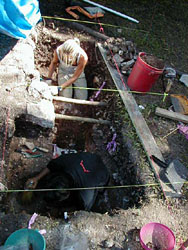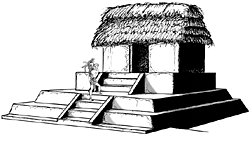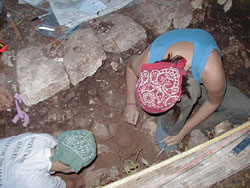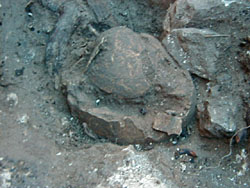

| |
| Pook's Hill: The Eastern Shrine |
"Maya Caves of West-Central Belize" August 21, 2000 |
| by Christophe Helmke | |
Based on information from several other lowland sites (e.g. Tikal, Caracol, Cahal Pech, etc.), we know that it was a common practice for the Maya to bury their dead in front of the shrine in the plaza once all of the burial positions within the shrine itself had been occupied. Therefore, we set up one excavation unit at the base of the eastern shrine, excavated in 1999, in order to search for burials.
Outset Staircase
Typically Maya temples and shrines have a principal staircase that leads to the summit of the building platform. These staircases are usually outset from the base of the platforms, meaning that they jut out onto the plaza. In 1999 we searched for architectural evidence of an outset staircase but none was found, so we drafted the reconstruction drawing of the shrine without an outset staircase. This year, while excavating in front of the shrine, we found the lowest step five centimeters below the surface. Following this step in the excavations, the entire outline of the outset was defined. It appears that looters had partially dismantled the staircase in search of cached offering or burials, thereby leaving us only with the lowest step. With the rediscovery of the outset, we corrected the reconstruction drawing to incorporate the more typical staircase. Right, Meghann Lundy and Nazario Puc excavate and clear the outset staircase of Structure 4A. |
 |
 Original sketch (Christophe Helmke, 1999) |
 Revised drawing (Christophe Helmke, 2000) |
Burial 1
As we were searching for burials and offerings that would have been placed in front of the shrine, we excavated downward in front of the outset staircase. Within the first week we found a small depression cut into the bedrock that contained fragmentary leg bones. The leg bones were parallel to the lowest step and the feet were found at the northern end of that step. This suggested that the burial was laid to rest in the manner typical of the Belize Valley: body extended, oriented north-south, with head to the south. We spent the second week opening another excavation running southward along the lowest step to uncover the entire skeleton. Once it was cleared, we found that the Maya had dug a pit directly in front of the staircase that penetrated through all the previous plaza floors. They had excavated to bedrock and cut a bathtub-shaped depression into the softer limestone in which to lay the body. Based on the orientation of the skull, it appears that the body was buried on its stomach in the prone position.
 Megan Bassendale and Jennifer Piehl clear Burial 1 in front of the outset staircase. |
 The back of the skull in Burial 1, partly cleared. |
No burial goods were found associated with this interment, but the individual was found to have all of his incisors and canines modified by filing. The cutting edge of the upper teeth were modified into M shapes and the lower teeth into V shapes, which were subsequently worn down by years of chewing. Filing was a common practice used to embellish the teeth of males, females, and children of most social levels. Although the types of tooth-filing encountered are relatively standard, we do not yet know whether these signaled adherence to specific lineages, social standing within lineages, or another as yet unidentified feature. We do know that modified teeth do not function as status indicators and that filing was an important rite of passage.
 The teeth of the individual of Burial 1, modified by filing. |
Burial 2
To the east of the first burial we encountered a concentration of cranial fragments. At first we thought that this represented part of a secondary so-called "bundle burial" that would have been included within Burial 1. However, the bones were beneath the outset staircase, and thus must predate Burial 1, which we believe postdates the staircase's construction because of its alignment. We began the last week of investigations by dismantling the northwest corner of the outset staircase to reach Burial 2. We removed the cut stones and part of the masonry backing of the staircase and hit the plaza floor the Maya had cut through to place Burial 1.
 The cache of ceramic vessels overlying Burial 2 |
We found a cache of at least five fragmentary ceramic dishes under the surface of the floor. Some of the dishes date to the last phase of the Early Classic (ca. A.D. 500-600), while others date to the first phase of the Late Classic (ca. A.D. 600-700). One of the dishes contained charred jute shells and carbon, indicating that an organic substance was burnt in the dish. It seems possible that the offering was copal, a type of resin used as incense by the ancient and modern Maya. Although the cache appears to be contextually associated with the burial, the vessels were placed in the ground as the burial was being filled in (five to 15 centimeters of fill separates the skeleton from the dishes). This suggests that the cache represents a separate offering that is contemporaneous with the burial. Therefore, we don't consider the dishes overlying the skeleton to be grave goods.
Burial 3
Having cleared all the bedrock in front of the outset staircase, we shifted our attention to the outset staircase itself. Customarily the Maya deposited offerings in the masonry of buildings before, during, and after the construction of a new phase. By excavating the remains of the outset staircase itself, we hoped to find such cached offerings, allowing us to date the construction of the staircase. Within the first few hours of excavations into the masonry a large concentration of fragmentary ceramic vessels, the long bones of legs, and fragments of a skull were found. During the removal of the skeleton, we found a second skeleton alongside the first. The roots of a tree growing directly in the center of the outset staircase appear to have engulfed most of the second skeleton. Consequently, only its legs and skull could be retrieved.
The ceramic concentration lay directly over the individual's midsection and allowed us to date the burial to the last phase of the Late Classic (ca. A.D. 850-900). Included were fragments of Belize Molded-carved vases, a censer whose sherds were strewn all over the skeleton (as though it had been smashed over the deceased person), a fragmentary dish vase, and a fragmentary ceramic torch holder. The presence of a torch holder is particularly suggestive since it is a ceramic form that is intimately associated with cave usage. Torch holders are found in the Early Classic (A.D. 300-600), but they are found most frequently during the Late Classic (A.D. 600-900). Although torch holders are equally as useful on the surface during the night, their increased manufacture during the Late Classic suggests that these may also have been consciously tied to cave usage in antiquity. The fragmentary Belize Molded-carved vases are also suggestive, since this type of pottery has also been found in Actun Nak Beh and Actun Tunichil Muknal.
Burial 4
Having removed the skeletons of Burial 3, we excavated down through the masonry of the outset staircase, finding a fourth burial. Like Burial 3, Burial 4 was apparently buried directly into the masonry of the outset. This skeleton was not accompanied by burial goods, but three olivella shells around its right wrist suggests that he or she wore a small bracelet. Based on the few ceramic sherds present in the masonry, this burial can also be dated to the last phase of the Late Classic (A.D. 850-900).
 Burial 4 once cleared. Note the row of stones to the top and left. These are the western and southern facing stones of the outset staircase, respectively. Note that the northwest corner of the outset has been excavated through to reveal the position of Burial 2. |
During the salvage excavations conducted in 1999, the remains of at least four skeletons were recovered. Adding the five we found this season brings the present total of skeletons associated with the shrine to nine. The concept of "mausoleum" as attributed to the shrines of plazuela groups at Caracol thus appears fitting. Due to time constraints we could not excavate the entirety of the outset, but it seems likely that additional burials lie buried within. [Next...]
Advertisement

Advertisement






